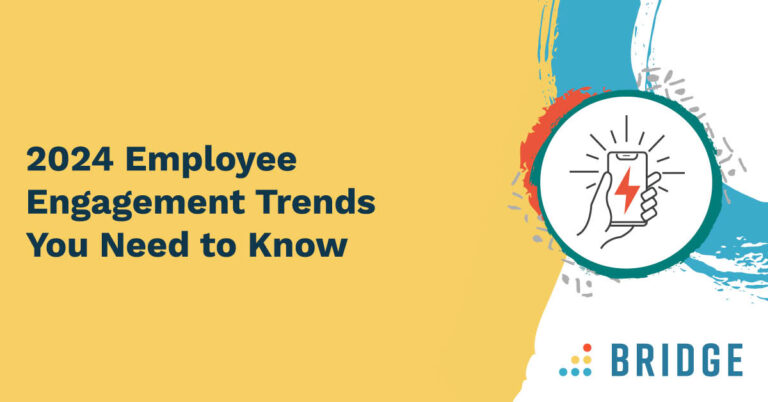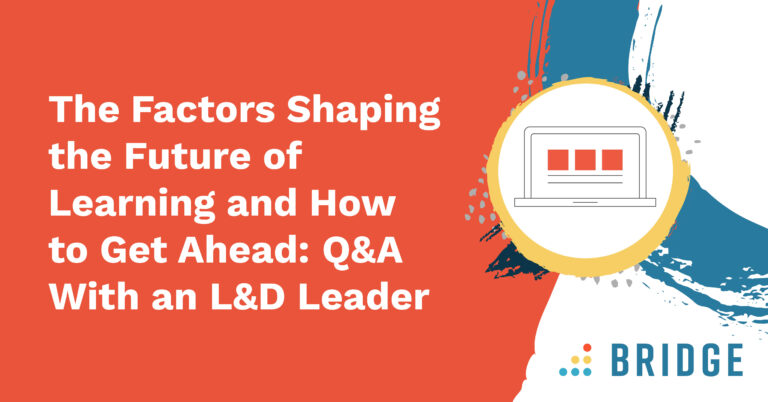Does your workforce enjoy strong levels of employee engagement? If you’re confident that the average employee at your organization is highly engaged, you’re actually in the minority: only 21% of HR professionals feel the same way.
This snapshot of the ongoing struggle to achieve strong engagement is one of the key takeaways from the Bridge-sponsored “Future of Employee Engagement 2023-24” report. Drawing on responses from hundreds of primarily North America-based HR professionals across a range of industries and organization sizes, our report tackles:
- The struggle faced by HR professionals to take action on engagement data
- The role played by supervisors, trust, and culture in securing engagement
- Key practices organizations leverage to achieve better engagement
- The technologies that are on the brink of addressing engagement-related tasks
While the full report is brimming with engagement insights, we’ve whittled down the data to three core details. Read on to discover the current state of employee engagement, the key areas impacted by engagement, and the current challenges in the world of engagement measurement.
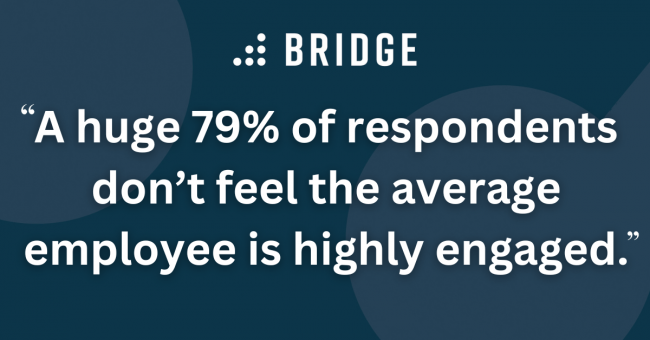
1) Employee Engagement Is Stagnant
When you’re charting employee engagement trends, it’s important to take a nuanced approach. That’s why “The Future of Employee Engagement 2023-24” offers a few different perspectives on the state of play for employee engagement—and each one points to either dormancy or decline.
For example, respondents were asked to indicate how engaged the average employee at their organization is on a scale from one (low) to 10 (high). Only 21% answered eight or higher, which leaves a huge 79% of respondents who don’t feel the average employee is highly engaged.
The data tells a similar story across the report. When respondents were asked what percentage of their workforce is highly engaged, only around a quarter felt that more than 60% of their colleagues could be placed in that category.
It’s worth noting that these low figures aren’t universal (or inevitable!). Among those respondents designated “engagement leaders” (those who rated the average employee’s level of engagement at eight out of 10 or higher), three-quarters felt that over 60% of their workforce is highly engaged. That’s good news: it suggests organizations can overcome the broader trend toward low and declining engagement.
This picture of individual successes and broader stagnancy is reflected in the report’s data on how engagement is changing. While around a third of organizations did see improvements in engagement over 12 months, another third saw a decline—while the final third remained the same.
On a worldwide level, the knock-on effects of low engagement are well documented. According to Gallup, worker disengagement costs the global economy close to $9 trillion. But while this kind of statistic gets across the urgency of the problem, its sweeping scale makes it a little detached from the everyday. That’s why our report shines a light on the practical impacts engagement can have on key aspects of an organization.
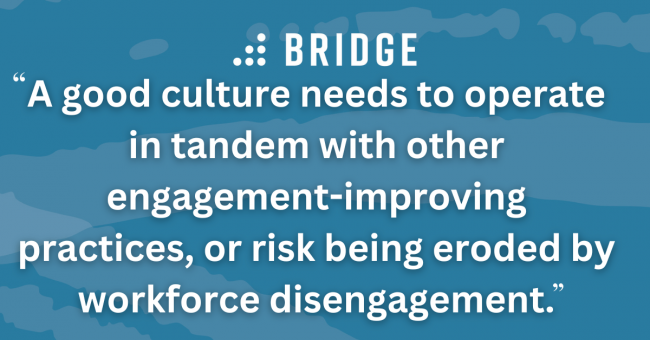
2) The 3 Key Impacts of Employee Engagement
Nobody needs to be persuaded that low employee engagement has negative consequences. But acknowledging the specific impacts that poor engagement can have across your organization is a great incentive for change. We asked respondents to name the top three areas impacted by employee engagement. Here’s what they had to say.
i) Employee Engagement Has a Bearing on Retention Rates
A substantial 64% of respondents named employee retention as one of the areas most heavily impacted by poor engagement. Thinking about engagement through the lens of retention is a great way to underscore the urgency attached to keeping your people engrossed in their work. While the enormous worldwide costs of poor engagement can be tough to visualize, the financial burden of employee turnover is much easier to grasp.
According to the Chartered Institute of Personnel and Development, low retention rates are associated with various forms of cost and outlay. These can range from indirect costs, like management or administrative time, to the more direct costs associated with recruitment agencies, advertisements, and so on. As such, the price of poor engagement is paid by:
- The administrative costs involved in resignations
- Recruitment and selection costs
- Covering the post for as long as there’s a vacancy
- Induction training for replacement employees
- Other, more complex costs involving factors like lost productivity during vacancy periods and the time to value for incoming candidates
MORE FROM THE BLOG | ‘30 Employee Engagement Questions You Need to Ask in Your Next Survey’
ii) Engagement Impacts Company Culture—And Vice Versa
Company culture can be an important catalyst for change and innovation—and, by extension, a poor culture can come with highly practical pitfalls. For 64% of respondents, culture was one of the key areas impacted by engagement, suggesting poor engagement can have a detrimental impact on that all-important company ethos.
That said, the report equally suggests that organizational culture isn’t a one-way street. Culture isn’t just a victim of poor engagement: it’s equally a means of improving that engagement.
You only need to take a look at the report’s engagement leaders to see this principle in action. 61% of leaders have activities designed to nurture a positive culture, compared to just 23% of laggards, suggesting that a good culture can contribute to stronger engagement.
That said, you can’t ignore the 64% of respondents who felt that culture is impacted by engagement. Culture alone can deteriorate at the hands of poor engagement—meaning a good culture needs to operate in tandem with other engagement-improving practices, or risk being eroded by workforce disengagement.
iii) Engagement and Productivity Go Hand in Hand
42% of respondents named productivity among the top areas in which engagement impacts their organizations.
This finding corroborates previous research which found that engaged employees experience an 18% increase in productivity when compared to their less engaged counterparts.
Like poor retention, productivity losses are a tangible consequence of poor engagement. Lower productivity can only lead to less-than-ideal business outcomes—underscoring that, while poor engagement may be widespread, it’s essential to understand and address engagement problems. And it all begins with effective measurement.
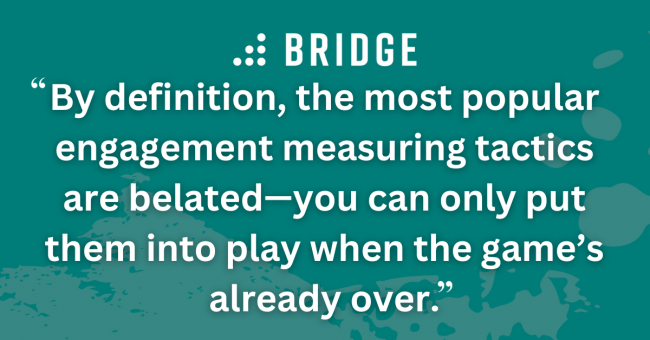
3) Employee Engagement Measurement Needs to Be More Proactive
You can’t address engagement problems (or, potentially, even recognize that you have any!) without the ability to measure engagement. According to our study, this is a problem faced by 42% of organizations, which—whether through a lack of capability or inclination—don’t measure engagement at all.
There’s no question that engagement measurement has a positive impact on employee engagement. The data shows that engagement leaders are twice as likely to measure engagement than laggards, suggesting a clear link between getting to grips with employee engagement and taking steps to improve it.
That said, not all forms of engagement measurement are equally effective. And the most popular methods aren’t necessarily the most successful. According to the report, the top three measurement methods are:
- Annual surveys (66%)
- Exit interviews (57%)
- Retention rates (54%)
On the face of it, these seem like reasonable strategies. If your people are leaving as a result of disengagement, surely exit interviews and broader retention rates are a good opportunity to review your engagement efforts, right? But here’s the problem: by definition, the most popular engagement measuring tactics are belated—you can only put them into play when the game’s already over.
Limiting engagement surveys to an annual cadence comes with the same caveat. By the time your yearly survey rolls around, plus the time it takes to collate, digest, and action the insights it reveals, the situation may well have changed, leaving you a step behind.
So, what’s the solution? It’s all about ensuring you can produce surveys quickly and easily for instant insight into employee engagement, giving your people plenty of opportunities to supply frequent or continuous feedback. Combined with the granular, team-based check-ins and intuitive manager dashboards offered by Bridge, you’ll have no trouble keeping track of your people’s engagement needs—and ensuring those needs are met.
MORE BRIDGE-SPONSORED INSIGHTS | ‘261 Learning Management System (LMS) Statistics and Tech Trends for 2023 and Beyond’
Enjoy a Wealth of Employee Engagement Insight With Our Full Report
Discover up-to-the-minute insights on actioning engagement data, preparing for stronger engagement, and the practices used by engagement leaders—all drawn from the responses of hundreds of HR professionals. Download the full report today, or get in touch to experience the power of Bridge’s engagement survey software for yourself.
